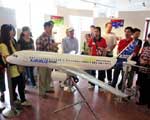China's 1st solar thermal power project starts bidding
(Xinhua)
2010-10-21 17
|
|
BEIJING - China's first solar thermal power plant began soliciting tenders on Wednesday as the country's efforts to diversify its clean energy sources gathered pace.
The 50 megawatt solar thermal power plant will rise on uninhabited land of more than 100 hectares in Hangjinqi in North China's Inner Mongolia autonomous region.
The tenders are scheduled to be opened on Jan 20, 2011. The China Machinery and Equipment International Tendering Co, Ltd is entrusted by the National Energy Administration to oversee the bidding process.
The project is estimated to cost about 1.6 billion yuan ($240.5 million) and will annually generate about 120 million kilowatt-hour of power, according to statistics from Inner Mongolia's reform and development commission.
Solar thermal power plants use the sun heat to generate steam and drive turbines. The plants store heat during the day and use it to generate power at night, providing greater power supply stability than photovoltaic plants. In addition, solar thermal plants do not need the expensive solar panels. The production of solar panels also require significant amounts of energy.
Hangjinqi was chosen over other sites in Northwest China because it was closer to the grid and had sufficient sunlight and water supplies, said Li Rong, head of Hangjinqi's investment promotion department, who has spent about five years working on the project. The project was approved by the National Development and Reform Commission in 2007.
The plant's initial planning and feasibility report was written by Inner Mongolia STP Development Co Ltd, a joint venture between Inner Mongolia Lenon New Energy Liability Co Ltd and the German company, Solar Millennium AG.
Experts say the opening of the plant marks the beginning of China's solar thermal power industry.
Solar thermal power plants have greater potential than photovoltaic power plants and may even challenge traditional thermal power plants. "China doesn't want to lag behind in its development," said Wang Zhifeng, a researcher at the Institute of Electrical Engineering, Chinese Academy of Sciences (IEECAS).
Nevertheless, the project bears some criticisms. "The project is not large enough. The larger a solar thermal power plant is, the lower the cost for each kilowatt an hour of electricity generated," said Ma Shenghong, the other researcher at IEECAS. "Ideally, a solar thermal power plant needs to have a capacity of more than 200 megawatt."
But analysts say the current project could be a basis for future expansion.
Solar thermal energy is still in experimental stages in China. It faces the obstacles of low efficiency and high developing costs, said Luo Zhentao, an expert at the China Association of Rural Energy Industry.
More than 30 leading Chinese companies and research institutes in solar energy came together to form the National Alliance for Solar Thermal Energy, Ministry of Science and Technology, in October 2009.
Meanwhile, Chinese research institutes, including some under Tsinghua University, are working on devices that can capture and store more heat, which will bring down the cost of solar thermal power plants and provide greater power stability.
Both photovoltaic power and solar thermal power plants have their advantages and disadvantages. For the first kind of power plant, an industrial chain of plants already exists, while solar thermal power technologies have barely gotten out of the lab, Ma at IEECAS said.
"So far, there is no solar thermal power plant in China, not even in Asia," Ma added. Solar thermal power can be applied extensively in parts of north and west China, such as Inner Mongolia autonomous region, Gansu, Xinjiang Uygur autonomous region , Ningxia Hui autonomous region, Qinghai and Tibet autonomous region. But a few challenges need to be addressed before the industry can develop more rapidly, said Xu Honghua, an expert at the National Energy Expert Consultative Committee.










